【Key Points】
・The left or right structures of chiral (Note 1) crystals turned out to be distinguishable by magnets, which were normally thought to only be able to distinguish between north and south.
・When an alternating current is applied to a chiral superconductor (Note 2), electron spins (Note 3) corresponding to the left or right structure of the crystal are induced.
・The study succeeded in providing a fundamental understanding of the left-right fractionation (optical resolution) of chiral molecules using magnets.
・It is also expected to develop as a spin source for future superconducting spintronics (Note 4).
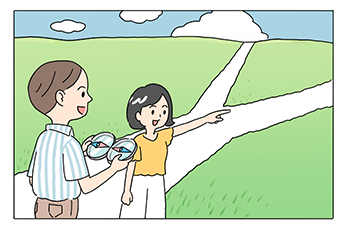
Abstract
Chirality control of molecules and crystals is an important issue in many fields such as drug discovery and display development. In recent years, in addition to the chemical chirality resolution that has been used up to now, attempts have been made to use magnets to fractionate the chirality of molecules. However, the principle has been a little difficult to understand and ambiguous, given the symmetry of the physical laws.
A research team led by Professor Hiroshi Yamamoto, consisting of Assistant Professor Daichi Hirobe (currently at Shizuoka University) and Graduate Student Ryota Nakajima (Graduate University for Advanced Studies) of the Research Centre of Integrative Molecular Systems at the Institute for Molecular Science, in collaboration with Professor Hiromi Okamoto and Assistant Professor Tetsuya Narushima (currently at MEXT) of the Centre for Mesoscopic Sciences at the same institute, has successfully observed spin accumulation in chiral superconductors by applying the latest technology for electronic devices based on organic chiral superconductors. The research team clarified the relationship between the chiral crystal structure and spin accumulation, which had been ambiguous, and demonstrated that chirality can indeed be recognized on the surface of a magnet.
The results of this research were published in Nature on January 19, 2023.
1. Backgrounds
When looking at a reflection in a mirror, everything that has a left/right distinction appears to have its right/left side reversed. In the mirror, the parting of the hair appears to be opposite, the heart appears to be on the right and the hands of a clock pointing to 9 o'clock appear to be pointing to 3 o'clock. Substances that undergo a left-right reversal when reflected in a mirror in this way are said to be chiral (Fig. 1). For chiral molecules, it is very important to separate the left and right shapes, as there are many cases in which right-helix (right-handed) molecules are the drug and left-helix (left-handed) molecules are the poison, for example. On the other hand, as far as physical laws are concerned, there is no right world or left world, so reflecting them in a mirror does not change the laws (this is limited to the world in which we normally live; the situation is different in the world of elementary particles).
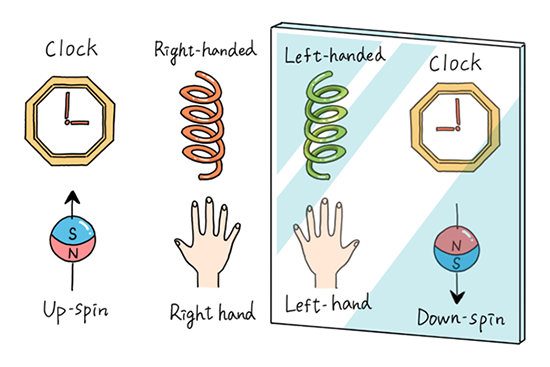
Figure 1: The left-right reversal of various objects when they are reflected in a mirror. When reflected in a mirror, a right-handed helical molecule becomes left-handed, and an UP spin becomes a DOWN spin (the axis of rotation of the spin and the mirror are assumed to be parallel here).
However, when chirality and electromagnetism are combined, something slightly different happens. For example, let's pass an electric current through a right-handed coil (electromagnet), as shown in Fig. 2a, and place a magnetic directional needle around the coil. The direction of the directional magnetic needle will then point in the direction shown in the diagram, which is exactly the same as the magnetic lines of force created by a magnet with the S pole at the top and the N pole at the bottom. If the winding of the coil is changed from right-handed to left-handed, the direction of the magnetic field lines also changes, so that it seems as if the left-right winding of the coil can be distinguished by looking at the direction of the magnetic field lines. The point here is that if you know in advance both how the coil is wound (chirality) and the direction of the current, you can determine the direction of the magnetic field lines in an unambiguous way.
Now let’s think about possibility to recognize microscopic by magnet. To tell the truth, the microscopic world in which molecules live is not so simple. First of all, the helical structures in matter are so small that it is very difficult to know in advance how they wind. Also, chiral molecules move freely in gases and solutions, and the electrons in the molecule can swing in many different directions. In the example above, we do not know neither how the coil is wound nor the direction of the current. It is necessary to determine the left or right (chirality) of the molecule under these circumstances. So, let's try again and see if we can distinguish between right-handed and left-handed coil windings by looking only at the magnetic field lines (Fig. 2c). In other words, can we distinguish the winding of the coil just by looking at the direction of the electromagnet? Actually, this is not possible. This is because if you turn over the coil winding and the direction of the current at the same time, you will get exactly the same magnetic field lines. Thus, the conventional view is that it is not possible to determine the left or right (chirality) of a chiral substance by the direction of the magnet alone.
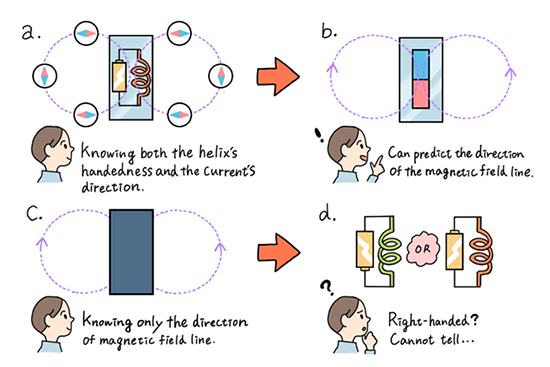
Figure 2: (a) The magnetic field lines of an electromagnet can be predicted if the winding of the coil and the direction of the current are known. In the central box, the current flows from top to bottom against the right-handed coil, so the surrounding azimuthal magnets line up as shown. (b) The observer knows what is in the box and is satisfied that the magnetic field lines are the same as for a magnet with S-pole at the top and N-pole at the bottom. (c) Magnetic field lines are emitted from the box containing the electromagnet. Can an observer see how the coil is wound when the contents are not directly visible? (d) The direction of the magnetic field lines alone does not determine whether the coil is right-handed or left-handed, as there are two possible combinations of coil winding and current direction.
Achievements
Nevertheless, recent researches have reported that it is now possible to recognize left or right of a chiral molecule using a magnet. This is based on the CISS effect (Note 5; CISS = Chirality-Induced Spin Selectivity), which proposes that electrons passing through a chiral molecule emerge with their spins aligned (Fig. 3). The spins emitted from left-helix molecules are the same as the velocity of electrons. The spin emitted from right-helix molecules will be in the opposite direction, showing connection between spin direction and the handedness of the molecule. For example, DNA is a right-handed molecule, so when an electron passes through DNA, its spin emerges in the opposite direction (backwards) to the direction in which the electron is travelling.
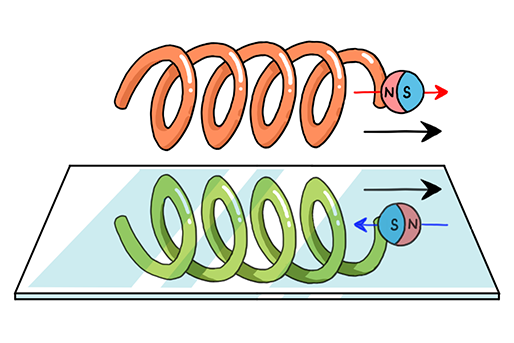
Figure 3: Schematic diagram of the CISS effect, in which electron spins are directed parallel or anti-parallel to the direction of travel as electrons pass through a chiral molecule. In reality, chiral molecules come in a variety of shapes, but for clarity, the left or right structures of the molecule are represented here by the helical structures found in DNA, for example.
At first glance, it would seem that the spins of the electrons aligned by the CISS effect can be used to determine the right or left structure of the molecule. However, as molecules can freely rotate in gases and solutions, the spins produced by the CISS effect will also rotate together. This means that the left and right molecules can become exactly the same 'electromagnet', so even if you prepare an external magnet, it is unlikely that you will be able to distinguish the handedness of the molecule.
This led to the hypothesis that if two spins facing away from each other were at both ends of the molecule, it would be possible to distinguish the right/left of the chiral molecule. The idea is to consider not only the electrons that pass through the chiral molecule, but also the spins of the electrons that are left behind. If two spins facing away from each other are placed on a molecule and the molecule is spun round and round, the spin pairs remain facing away from each other. However, when mirrored, the spin pairs change direction and look at each other, so they are indeed chiral (Fig. 4). However, the molecule is so small that no one could be sure whether such 'two mutually facing spins' existed in a chiral molecule, so it remained to be experimentally proved.
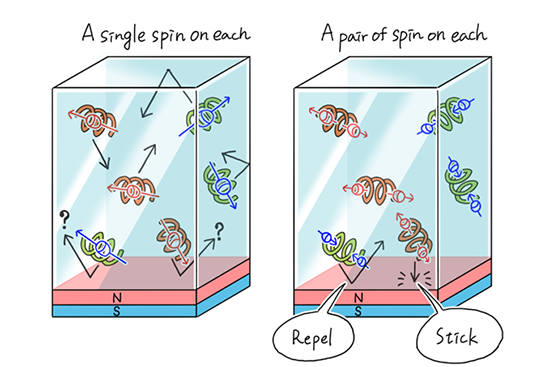
Figure 4: Consider the situation where the chiral molecule, due to the CISS effect, has been given a spin. The molecules are in free motion in the box, but if a magnet is placed underneath, the magnet and the chiral molecule should magnetically stick together or repel each other. If the chiral molecule has only one spin, as in the box on the left, the spin rotates along with the rotation of the molecule, so the left/right structure of the chiral molecule cannot be distinguished by the magnet. However, if, as in the box on the right, the chiral molecule has 'two mutually oriented spins' and their 'inward/outward orientation' is determined by the handedness of the molecule, then the left/right structures of the molecule can also determine whether they are attached to or repelled by a magnet. The existence of such two spins in a chiral molecule has been proposed as a hypothesis to explain the experimental results, but no one has ever seen it.
The research group considered that chiral molecules as they are are too small to observe the spin distribution, and came up with the idea of conducting verification experiments using 'chiral superconductors', which have a larger chiral structure. Although there are many electrons in a superconductor, the quantum mechanical wave phases (see note 2) are aligned, potentially allowing quantum mechanical interference effects (see note 6), such as those seen in molecules, to be observed on length scales at least a thousand times larger. In other words, the chiral superconductor could become one large chiral molecule, and the CISS effect could be 'magnified' and detected.
The research group therefore attached electrodes to a chiral organic superconductor called κ-(BEDT-TTF)2Cu(NCS)2 and started experiments in which alternating current was applied (Fig. 5). At that time, the top and bottom electrodes were made of magnets so that the up and down spins coming out of the superconductor could be monitored as a voltage. Alternating current was also used to reproduce the state in which the electrons in the solution are shaken by the free movement of the molecules in the solution. When κ-(BEDT-TTF)2Cu(NCS)2 became superconducting at low temperatures, indeed, 'two mutually directed spins' appeared at the top and bottom of the chiral superconductor crystal. Furthermore, when the right/left structures of the crystal are reversed, the inward and outward directions of the spin pairs are also reversed. This proves that the chirality of a crystal can indeed be determined by observing the spins of a chiral superconductor from the outside with a magnet.
By the way, just as the N and S poles are reversed when the current in an electromagnetic coil is reversed, spin can also be reversed by reversing the direction of time. In other words, the 'two mutually oriented spins' found in this study express a strange chirality, in which the left/right handedness can be also reversed by time reversal. This would never happen in the chirality of a molecule or crystal. This is because right-handed molecules remain right-handed and left-handed molecules remain left-handed even if the direction of time is reversed. This unchanged thing in time reversal is called 'even about time reversal' in physics. Conventionally, it was thought that the chirality of the spin, which is turned over by such time reversal (Note 7), and the chirality of the molecule were largely unrelated. However, in this experiment, it was found that the chirality of the spin that switches sides in a time reversal can be used to distinguish the chirality of the molecule from the outside. The research group named this 'chirality with odd time reversal (T-odd chirality)', emphasizing that the time reversal for this chirality is not even.
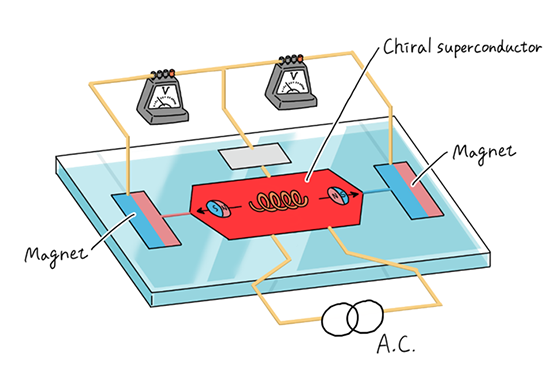
Figure 5: Schematic diagram of a chiral superconductor device. The wire pattern and chiral superconductor are on a plastic substrate. Some of the wires are made of magnets (nickel) and by measuring their voltage, the direction of the spins in the chiral superconductor can be detected. In this experiment, the spins that emerge at the two ends of the superconductor were detected when an alternating current was passed through the middle of the chiral superconductor.
3. Perspectives
The results of the present study show that left-right separation of chiral molecules by a magnet is in principle possible. In the future, by theorizing such phenomena using mathematical formulae, guidelines for improving the efficiency of optical resolution of chiral molecules will be established, and research into drug discovery and the development of functional molecules using chiral molecules is expected to be accelerated. Furthermore, the technology used in this experiment has the potential to be used in the field of superconducting spintronics in the future. In the conventional superconducting state, it is very rare for electron spins to become active, and it has been experimentally difficult to extract spins stable enough to be used for memory and computation. However, this experiment has shown that spins can be easily induced in the superconducting state using a chiral superconductor. In the superconducting state, the electrons behave as coherent waves, and this wave property is actively used in quantum computers. If we can add spin, which has strong quantum mechanical properties, it is expected to lead to the development of a new type of quantum computer using spin.
4. Technical Terms
(Note 1) Chiral/Chirality: Some microstructures (arrangement of atoms) of molecules and crystals have a structure that cannot be superimposed on the original structure when mirrored, as in the same way as the right and left hands. Molecules and crystals with such structures are called chiral molecules and chiral crystals, and this distinction between left and right is called chirality. The Nobel Prize in Chemistry 2001 was awarded to Dr Noyori, Dr Knowles and Dr Sharpless for their work in the creation of chiral molecules by catalysis. The Institute for Molecular Science received Asia's first ' Citation for Chemical Breakthrough Awards' from the American Chemical Society for the same research.
(Note 2) Superconductivity/Superconductor: When metals that conduct electricity are cooled, the scattering of electrons due to heat decreases and their electrical resistance decreases, but in general their resistance never reaches zero. However, some metals are known to suddenly reduce their electrical resistance to zero at certain temperatures and such a phenomenon is known as superconductivity. Materials that exhibit such phenomena at low temperatures are called superconductors, to distinguish them from ordinary metals. In a superconductor, electrons behave like a single large wave with coherent phases.
(Note 3) Electron spin: The electron has a degree of freedom that can be likened to the rotational motion of the moon or the earth, and this rotation is named spin, with the axis of rotation represented by an arrow. Furthermore, electron spin is known to behave as a small magnet. The laws of quantum mechanics and relativity apply to small, quick particles like electrons. As a result, the axis of rotation of the electron spin is limited to two directions, 'up' and 'down', and never stops. This is why each individual electron is always a small magnet.
(Note 4) Spintronics: A field of research in which the properties of electrons as magnets are used for information processing as well as optical/thermal control. Combined with the electrical properties of electrons, they may be used in a variety of devices, including digital information circuits. Familiar examples include devices that detect the N and S poles of a magnet by the magnitude of their electrical resistance, such as the magnetoresistive elements that have made possible the high density of hard disk drives. Electron spins have strong quantum mechanical superposition properties, and quantum computers using such properties have also been proposed.
(Note 5) CISS effect: Abbreviation for Chirality-Induced Spin Selectivity, an effect whereby when an electron passes through a chiral molecule, its spin is aligned parallel (in the same direction) or anti-parallel (in the opposite direction) to the direction of electron travel. Whether it is parallel or anti-parallel depends on the handedness of the chiral molecule. The effect was discovered about 20 years ago, but the detailed theory of why such an effect occurs is still unknown. In recent years, it has been reported that, as an extension of the CISS effect, when mixed left-right chiral molecules are crystallized on the surface of a magnet, switching the N and S poles of the magnet can switch the left or right handedness of the molecules that emerge as a crystal.
(Note 6) Quantum mechanical interference effect: In the world of small particles (quantum) such as electrons and protons, matter behaves as waves. Waves have phases (peaks and troughs), so when multiple waves overlap, the peaks of the waves overlap each other to form large mountains, or the peaks and troughs overlap to form flats. Such effects are called interference effects of waves, and interference effects seen in 'quantum mechanics', which describes the motion of small particles, are specifically called quantum mechanical interference effects. Quantum mechanical interference effects are generally more difficult to observe as molecules and crystals become larger.
(Note 7) Time reversal symmetry: When considering the motion of things, some things change sign when time is reversed, while others do not. For example, the sign of 'mass' does not change when time is reversed, but the sign of 'velocity' becomes negative when time is reversed because the substance moves in the opposite direction. Thus, there are physical quantities that do not change sign with respect to time reversal (even functions of time) and those that do change sign (odd functions of time), and are said to be 'even with respect to time reversal' and 'odd with respect to time reversal', respectively. Chirality, like mass, is even with respect to time reversal, but the chirality of the spin-pair observed here differs from that of molecules and crystals in that it is odd with respect to time reversal.
5. Publication Information
Journal Name: Nature
Title: Giant spin polarization and a pair of antiparallel spins in a chiral superconductor
Authors: R. Nakajima, D. Hirobe, G. Kawaguchi, Y. Nabei, T. Sato, T. Narushima, H. Okamoto, H. M. Yamamoto
Publication Date: 18 January 2023
DOI:10.1038/s41586-022-05589-x
6. Research Group
This research was conducted in a research team consisting of Professor Hiroshi Yamamoto, Assistant Professor Daichi Hirobe (currently at Shizuoka University) and Graduate Student Ryota Nakajima (at the Graduate University for Advanced Studies) from the Research Center of Integrative Molecular Systems, Institute for Molecular Science, in collaboration with Professor Hiromi Okamoto and Assistant Professor Tetsuya Narushima (currently at MEXT) from the Center for Mesoscopic Sciences at the same Institute.
7. Financial Supports
This work was supported by Grants-in-Aid for Scientific Research (20K20903, 22K18695, 20H01866, 17H03014, 20H01863, 21H05439, 21H04641, 16H06505, 22H05135, 21K18884, 19H00891), JST Strategic Creative Research Promotion Programme PRESTO (JPMJPR20L9), JST Strategic Creative Research Promotion Programme ERATO (JPMJER1301) and other financial resources.
8. Contact Information
【On the research】
Hiroshi Yamamoto
Professor, Research Center of Integrative Molecular Systems, Institute for Molecular Science,
National Institutes of Natural Sciences
TEL: 0564-55-7334
E-mail: yhiroshi_at_ims.ac.jp
Daichi Hirobe
Assistant Professor, Faculty of Science, Shizuoka University
TEL: 054-238-4750
E-mail: hirobe.daichi_at_shizuoka.ac.jp
*Please replace the "_at_" with @
1126






